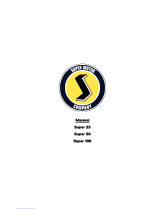
HondaVT750CDACE
ServiceIntervalandRecommendedMaintenanceManual5
TableofContents
Task#01‐DriveChain..................................................................................................................................................7
Task#02‐BrakeFluid...................................................................................................................................................9
Task#03‐BrakeWear................................................................................................................................................10
Task#04‐BrakeSystem.............................................................................................................................................11
Task#05‐BrakeLightSwitch.....................................................................................................................................13
Task#06‐HeadlightAim............................................................................................................................................14
Task#07–Clutch........................................................................................................................................................15
Task#08‐SideStand..................................................................................................................................................16
Task#09‐Suspension.................................................................................................................................................17
Task#10‐Nuts,BoltsandFasteners..........................................................................................................................18
Task#11‐Wheels&Tires...........................................................................................................................................23
Task#12‐SteeringHeadBearings..............................................................................................................................24
Task#13‐FuelLine&Filter........................................................................................................................................24
Task#14‐ThrottleOperation.....................................................................................................................................25
Task#15‐CarburetorChoke......................................................................................................................................26
Task#16‐AirCleaner.................................................................................................................................................26
Task#17‐CrankcaseBreather...................................................................................................................................27
Task#18‐SparkPlugs.................................................................................................................................................28
Task#19‐ValveInspection/Adjustment..................................................................................................................32
Task#20‐EngineOil&Filter......................................................................................................................................41
Task#21‐Removal&InstallationoftheWheels.......................................................................................................43
Task#22‐CarburetorSynchronization......................................................................................................................47
Task#23‐EngineIdleSpeed......................................................................................................................................49
Task#24‐RadiatorCoolant........................................................................................................................................49
Task#25‐CoolingSystem..........................................................................................................................................50
Task#26‐RearBrakeShoeReplacement..................................................................................................................51
Task#27‐FrontBrakePadReplacement...................................................................................................................56
Task#28‐ReplacingtheCoolant................................................................................................................................58
Task#29‐FrontBrakeDiscInspection&Limits.........................................................................................................62
Task#30‐FrontBrakeBleeding.................................................................................................................................63
Task#31‐PilotScrewAdjustment.............................................................................................................................65
























